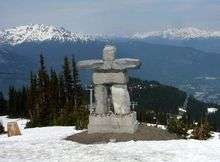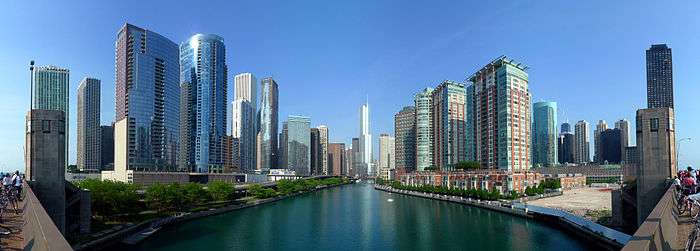Continental climate

Continental climates are defined in the Köppen climate classification as having the coldest month with the average temperature never rising above 0.0° C (32°F) all month long.
Continental climates often have a significant annual variation in temperature (hot summers and cold winters). They tend to occur in the middle latitudes (40 to 55 north), where prevailing winds blow overland, and temperatures are not moderated by bodies of water such as oceans or seas. Continental climates occur mostly in the Northern Hemisphere, which has the kind of large landmasses required for this type of climate to develop. Most of northern and northeastern China, eastern and southeastern Europe, central and southeastern Canada, and the central and upper eastern United States have this type of climate.[1]
In continental climates, precipitation tends to be moderate in amount, concentrated mostly in the warmer months. Only a few areas—in the mountains of the Pacific Northwest of North America and in Iran, northern Iraq, adjacent Turkey, Afghanistan, Pakistan, and Central Asia—show a winter maximum in precipitation. A portion of the annual precipitation falls as snowfall, and snow often remains on the ground for more than a month. Summers in continental climates can feature thunderstorms and frequent cool temperatures, however summer weather is more stable than winter weather.
Spring and autumn
The timing of intermediate spring-like or autumn-like temperatures in this zone vary depending on latitude and/or elevation. For example, spring may arrive as soon as early March in the southern parts of this zone, or as late as May in the north. Annual precipitation in this zone is usually between 600 millimetres (24 in) and 1,200 millimetres (47 in), most of it in the form of snow during winter. It also has cold winters and warm summers.
Köppen climate classification
Most such areas fit Köppen classifications of Dfa, Dwa (cold winters, hot summers; "w" indicating very dry winters characteristic especially of China) or Dfb or Dwb (cold winters, warm summers, same distinction for winter dryness). Dry summer continental climates (Dsa and Dsb) exist in high altitude areas near Mediterranean climates. In some cases, the semi-arid climate classification of BSk can also be considered to be continental as long as it has cold winters. The definition of this climate regarding temperature is as follows: the mean temperature of the coldest month must be below −3 °C (26.6 °F) and there must be at least four months whose mean temperatures are at or above 10 °C (50 °F).
Climatology
Continental climates exist where cold air masses infiltrate during the winter and warm air masses form in summer under conditions of high sun and long days. Places with continental climates are as a rule are either far from any moderating effect of oceans (examples: Omaha, Nebraska and Kazan, Russia) or are so situated that prevailing winds tend to head offshore (example: Boston, USA). Such regions get quite warm in the summer, achieving temperatures characteristic of tropical climates but are colder than any other climates of similar latitude in the winter.
Neighbouring climates
In the Koppen climate system, these climates grade off toward temperate climates equator-ward where winters are less severe and semi-arid climates where precipitation becomes inadequate for tall-grass prairies. In Europe these climates may grade off into oceanic climates in which the influence of cool oceanic air masses is more marked toward the west. The subarctic climate (Köppen: Dfc), with very cold, long and dry winters, but with at least one month above 10 °C (50 °F), might be considered a sub-type of the continental climate.
List of locations with a continental climate
North America

- Canada: throughout much of Southern Canada from the Rocky Mountains to Atlantic Canada. Major cities: Whistler; Prince George; Kelowna; Calgary; Edmonton; Fort McMurray; Saskatoon; Regina; Winnipeg; Kenora; Thunder Bay; Sault Ste. Marie; Greater Sudbury; North Bay, Ontario; Timmins; Sarnia; London, Ontario; Kitchener, Ontario; Toronto; Niagara Falls; Kingston; Ottawa; Val-d'Or; Montreal; Sherbrooke; Trois-Rivières; Quebec City; Saguenay; Sept-Îles; Fredericton, New Brunswick; Moncton, New Brunswick; Halifax; Sydney, Nova Scotia; Charlottetown, Prince Edward Island; St. John's, Newfoundland and Labrador
 A statue of Ilanaaq, mascot of the 2010 Winter Olympics, located on Whistler Mountain
A statue of Ilanaaq, mascot of the 2010 Winter Olympics, located on Whistler Mountain North Saskatchewan River valley in Edmonton
North Saskatchewan River valley in Edmonton The Forks, with St. Boniface Cathedral in the background in Winnipeg
The Forks, with St. Boniface Cathedral in the background in Winnipeg Toronto skyline taken from Colonel Samuel Smith Park in Etobicoke
Toronto skyline taken from Colonel Samuel Smith Park in Etobicoke- Downtown Calgary from Southern Alberta Institute of Technology (SAIT) campus
 Olympic Stadium in Montreal
Olympic Stadium in Montreal- Quebec City shore
 Halifax as seen from the Dartmouth waterfront
Halifax as seen from the Dartmouth waterfront Duckworth Street in St. John's
Duckworth Street in St. John's


- United States: throughout much of Northern United States, including parts of Alaska, and farther south at high elevations in Oregon, California, and Arizona, and along the Appalachian Mountains: Major cities: Spokane; South Lake Tahoe; Flagstaff; Idaho Falls; Wallace; Billings; Cheyenne; Salt Lake City; Aspen; Denver; Fargo; Sioux Falls; Omaha; Kansas City; St. Louis; Des Moines; Minneapolis; Green Bay, Wisconsin; Madison, Wisconsin; Milwaukee; Chicago; Indianapolis; Detroit; Cincinnati; Cleveland; Columbus, Ohio; Youngstown; Pittsburgh; Philadelphia; Erie; Scranton; Wheeling; Oakland, Maryland; Boone, North Carolina; Buffalo; Rochester; Syracuse; Albany; New York City; Montpelier; Concord; Hartford; Worcester; Boston; Portland, Maine; Augusta, Maine; Juneau, Alaska.
 Rainbow Bridge and the American Falls in Niagara Falls
Rainbow Bridge and the American Falls in Niagara Falls
 Boone, NC as seen from Howard's Knob
Boone, NC as seen from Howard's Knob Boston's skyline in the background, with fall foliage in the foreground
Boston's skyline in the background, with fall foliage in the foreground San Francisco Peaks from Flagstaff, AZ
San Francisco Peaks from Flagstaff, AZ
South America
While there are no major cities in South America that fall in to the classification of a continental climate, there are some remote places that have this climate. Due to the influence of the Ocean, Patagonia, including cities such as Punta Arenas, Chile and Ushuaia, Argentina, have an average winter temperature above 0°C, and so are classified as an oceanic climate.
- Argentina: Moderately high elevations in the central Andes west of Mendoza, Argentina towards the Argentine Patagonia's internal areas; lying in the nation's southwestern frontier, near the Chilean border (e.g Bariloche)
- Chile: Moderately high elevations in the central and Andes east of Santiago, and within the interior of the Aysén region (e.g: Balmaceda)
Europe


- France: Chamonix
- Belgium: Bertrix
- Italy: Bruneck, Cortina d'Ampezzo
- Austria: Innsbruck, Salzburg (bordering an oceanic climate)
- Switzerland: Bern
- Germany: Garmisch-Partenkirchen
- Norway: Oslo, Trondheim, Lillehammer
- Sweden: Stockholm, Gothenburg
- Finland: Helsinki, Turku
- Estonia: Tallinn
- Latvia: Riga
- Lithuania: Vilnius
- Belarus: Minsk, Grodno
- Ukraine: Kiev, Kharkiv, Lviv
- Czech Republic: Prague
- Poland: Warsaw, Wrocław, Szczecin
- Slovakia: Bratislava
- Bulgaria: Sofia, Pleven
- Romania: Bucharest
- Bosnia and Herzegovina: Sarajevo
- Moldova: Chișinău
- Russia: throughout much of southern Russia except coastal Black Sea. Major cities: Moscow, Saint Petersburg, Kazan, Novosibirsk, Ulan-Ude, Abakan, Vladivostok
- Hungary :Budapest
Africa

Middle East
Asia

- Kazakhstan: Astana, Almaty, Oskemen, Oral
- Kyrgyzstan: Bishkek, Naryn
- Afghanistan: Kabul
- Uzbekistan: Nukus, Andijan
- Pakistan: Skardu
- India: Leh, Dras
- Mongolia: Ulaanbaatar, Ulaangom
- China: Ürümqi, Turpan, Shijiazhuang, Lhasa, Beijing, Harbin, Tianjin, Changchun, Heihe, Qiqihar, Xining
- North Korea: Pyongyang, Nampo
- South Korea: Seoul, Suwon, Incheon, Daejeon, Sejong City, Cheonan, Cheongju, Gangneung, Wonju, Chuncheon, Pyeongchang County
- Japan: Mostly found in the Hokkaido region as well as high elevations in Mainland Japan: Major cities: Sapporo, Asahikawa, Nayoro, Kushiro, Obihiro, Kitami, Abashiri, Wakkanai, and Nemuro.
Oceania

- Australia: High elevations such as the Victorian Alps between Victoria and New South Wales and in Tasmania: Major cities: Mount Buller (bordering a subartic climate), Perisher Ski Resort (bordering a subpolar oceanic climate), Kiandra, Cabramurra, Charlotte Pass and Hotham Alpine Resort (both bordering a subarctic climate)
See also
References
- ↑ "Continental Climate". Encyclopedia of the Atmospheric Environment. Manchester Metropolitan University. Archived from the original on 2009-04-27.
External links
| Wikimedia Commons has media related to Continental climate. |